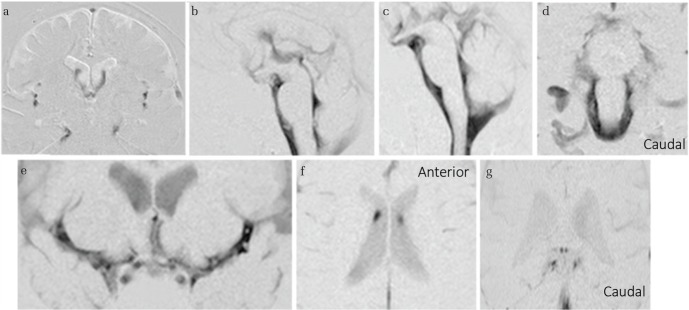Fig. 2.
Cerebrospinal fluid (CSF) motion in a healthy individual visualized using dynamic improved motion-sensitized driven-equilibrium steady-state free precession (dynamic iMSDE SSFP). In dynamic iMSDE SSFP, the dark regions on the grayscale images indicate vigorous CSF motion. The image contrast is achieved by the signal attenuation induced by irregular motions in each site compared with the surrounding site where CSF moves relatively mildly. With dynamic iMSDE SSFP, irregular motion is observed at the anterior horn, but not at the posterior half of the lateral ventricles (a and b). A motion that sprayed upward from the third ventricle to the anterior horn is visualized (a and b). Augmented motion at the Sylvian aqueduct is observed (b). Turbulent motions are evident in the third and fourth ventricles (b and c). Increased turbulent motion around the brainstem is observed (c and d). A turbulent motion proximal to the Sylvian fissure that attenuates as it transmits laterally (e). Although this augmented motion gradually attenuates toward the distal part of the Sylvian fissure, it also shows limited turbulence near the vascular structure (e). However, motion that attenuates toward the convexity of the cerebrum is not subsequently affected by additional driving forces and is visualized to maintain a suppressed movement (e). Depressed turbulent motion in the convexity is observed (a). Suppressed motion is observed in the trigone (f and g).The axial image shown in (f) confirms irregular motion propagated from the foramen of Monro at the anterior horn, but not at the posterior half of the lateral ventricles.

